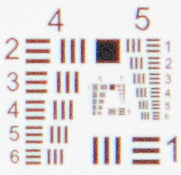Photo Corners headlinesarchivemikepasini.com
![]()
A S C R A P B O O K O F S O L U T I O N S F O R T H E P H O T O G R A P H E R
![]()
Enhancing the enjoyment of taking pictures with news that matters, features that entertain and images that delight. Published frequently.
Scanning Slides With A Camera




6 December 2013
A very long time ago we wrote about copying slides with a Nikon 990 and Nikon's slide copying accessory. It worked pretty well. But we never did experiment with a higher resolution dSLR. Until today.

Chart. We called it a G5-E6.
Cleaning up a corner of the studio, we ran across the old slide copying accessory and, desperate to take a break from our janitorial duties, we thought we'd shoot the USAF target with a dSLR. The result is shown to the right.
Our setup was a modest Nikon D300 with an old 50mm f1.4 lens mounted with a BR-2 reversing ring to give us a macro range. We put the slide itself in the old Coolpix slide adapter and aligned the two manually. Natural light for illumination. We focused using Live View.
That's not a perfect setup of course. We'd build a rig if we were going to do this for production work.
But we might. You can see the results, as far as resolution go, rival the OpticFilm and surpass the others in our OpticFilm 120 review, which we've updated with this note. Distinct lines are seen at G5-E6, ranking it at 2896 dpi.
Here's the table (G for Group, E for Element):
G0 G1 G2 G3 G4 G5 G6 G7 E1 51 102 203 406 813 1626 3251 6502 E2 57 114 228 456 912 1825 3649 7299 E3 64 128 256 512 1024 2048 4096 8193 E4 72 144 287 575 1149 2299 4598 9196 E5 81 161 323 645 1290 2580 5161 10322 E6 91 181 362 724 1448 2896 5793 11586 The one hitch is that camera interpolates color while the scanners all have individual red, green and blue readings for each pixel. The chart is, consequently, not quite neutral.
Still, looks like we might have to build that rig.